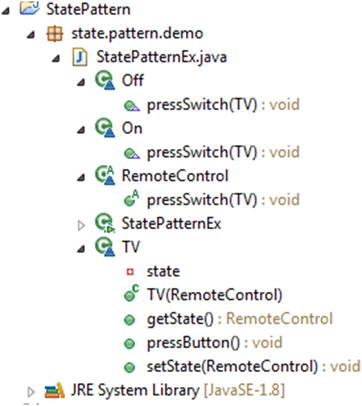CHAPTER 14
![]()
State Patterns
GoF Definition: Allow an object to alter its behavior when its internal state changes. The object will appear to change its class.
Concept
The concept is best described by the examples that follow.
Real-Life Example
Consider a network connection for the moment. Here the object (that is responsible for communication) can be in various states (e.g., already a connection is established, a connection is closed, or the object is listening through the connection). We can also think of a traffic signal in this context.
Computer World Example
The above example is applicable in the computer world also. Let us look at an additional example: We have a job processing application where we can process only one job (or any certain number of jobs) at a time. Now if a new job appears, either the application will process that job or it will signal that the new job cannot be processed at this moment because the system is already processing the maximum number of jobs in it (i.e., its number of job processing capabilities has reached the ceiling).
Illustration
Here we have picked a very simple switching mechanism for turning a TV on/off. Suppose, we have a remote control to turn the TV on/off. Initially the TV is in the off state. When we press the power button, the TV will be on; upon the next press of the button, the TV will go off. We have implemented this concept with the state design pattern here.
UML Class Diagram

Package Explorer view
High-level structure of the parts of the program is as follows:

Implementation
package state.pattern.demo;
abstract class RemoteControl
{
public abstract void pressSwitch(TV context);
}
class Off extends RemoteControl
{
@Override
public void pressSwitch(TV context){
System.out.println("I am Off .Going to be On now");
context.setState(new On());
}
}
class On extends RemoteControl
{
@Override
public void pressSwitch(TV context)
{
System.out.println("I am already On .Going to be Off now");
context.setState(new Off());
}
}
class TV
{
private RemoteControl state;
public RemoteControl getState() {
return state;
}
public void setState(RemoteControl state) {
this.state = state;
}
public TV(RemoteControl state)
{
this.state=state;
}
public void pressButton()
{
state.pressSwitch(this);
}
}
class StatePatternEx
{
public static void main(String[] args)
{
System.out.println("***State Pattern Demo*** ");
//Initially TV is Off
Off initialState = new Off();
TV tv = new TV(initialState);
//First time press
tv.pressButton();
//Second time press
tv.pressButton();
}
}
Output

Note
- As human beings, we perform best when we are happy and free of tension and our behavior can clearly reflect our mental state. It is obvious that when we are in a happy and relaxed mode, we can perform better and we can talk to others in a friendlier tone. But consider the reverse scenario: when we are full of tension. In that scenario, in most cases, our efforts cannot produce a great result. That is why it is always suggested that we should work in relaxed mode. You can relate this simple philosophy with the foregoing illustration. If the TV is on, it can entertain you; if it is off, it cannot—right? So, when we want to design similar kinds of behavior changes of an object when its internal state changes, this pattern becomes handy.
- If the number of states increases significantly in the system, then it becomes extremely hard to maintain that system.
